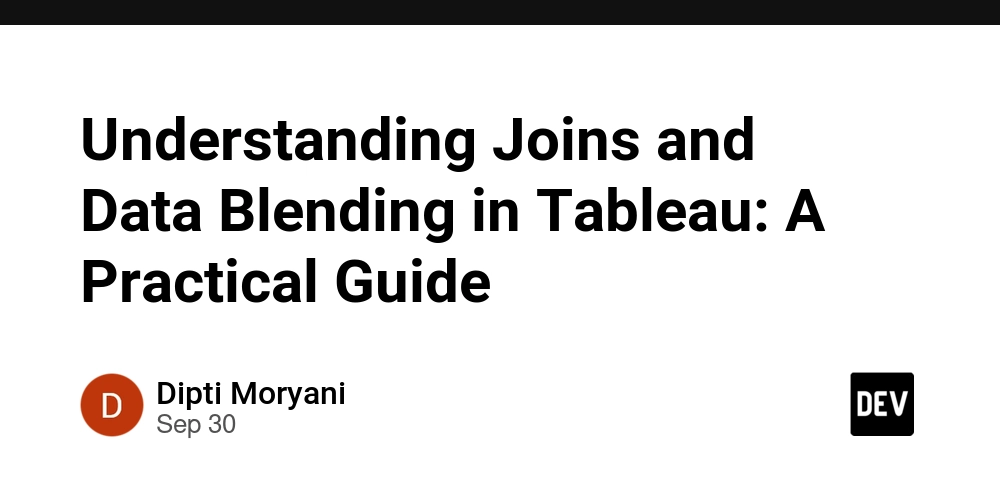Introduction
In the world of data analysis, rarely do we find all the information we need neatly stored in a single place. Businesses often deal with data scattered across different databases, files, or applications. For instance, sales data may be in one system, while customer demographics are in another. To make sense of the bigger picture, analysts need to bring these datasets together.
This is where Tableau, a leading business intelligence tool, comes into play. Tableau makes it easier to combine data either by joins or blending, giving analysts the flexibility to work with multiple data sources and create meaningful insights. However, understanding the difference between joins and blending—and when to use which—is crucial for effective analysis.
What Are Joins in Tableau?
At its core, a join is the process of combining two or more tables using a common field (often called a key). Think of it as stitching together rows of data based on shared information. For example, if you have a table of customer details and another of sales transactions, you can join them using a common field like Customer ID.
When joined correctly, the result is a new, unified dataset that allows for deeper analysis without jumping back and forth between multiple tables.
Types of Joins in Tableau
Tableau supports the four standard join types used across data analysis:
Inner Join – Keeps only the matching records between two tables.
Example: If you have customer data and sales data, only customers who actually made a purchase will appear in the joined table.
Left Join – Keeps all records from the left table and adds matching records from the right table.
Example: A left join between all customers and sales data ensures that even customers who didn’t make a purchase are included.
Right Join – The opposite of a left join; it keeps all records from the right table.
Example: If you want all sales transactions listed, even if some transactions don’t have complete customer details, a right join is useful.
Full Outer Join – Includes all records from both tables, regardless of whether they match.
Example: When you want a complete picture—customers with and without sales, and sales with or without linked customer info.
Case Study: Joins in Action
Imagine a retail company wants to analyze sales performance by geography. Sales numbers are stored in one table, while customer location data sits in another. By performing an inner join on Customer ID, the company can build a dashboard showing which regions contribute most to sales. Without joins, the analysis would be incomplete and scattered.
The Limitations of Joins
While joins are powerful, they have their boundaries:
They work best when datasets are stored in the same source or format.
Joins can cause data duplication if the relationship between tables isn’t one-to-one.
Large joins can slow down performance, especially with millions of rows.
This is where data blending becomes valuable.
What Is Data Blending in Tableau?
Data blending is Tableau’s way of combining information from different data sources that cannot be joined directly. Instead of merging tables at the row level, blending works by creating a relationship between two data sources—one designated as primary and the other as secondary.
Think of blending as asking two separate databases the same question and then merging their answers into one view.
When to Use Blending Instead of Joins
Different Data Sources – When data comes from separate platforms (e.g., an Excel file and a SQL database).
Different Levels of Detail – If one dataset contains daily sales and another only contains monthly targets.
Avoiding Duplicates – Joins may duplicate rows, while blending avoids this by aggregating results.
Large Datasets – Blending can sometimes handle larger, complex datasets more efficiently.
Case Study: Blending in Real Life
A multinational company tracks sales transactions in an internal SQL database but keeps sales targets in Excel files. Management wants to compare actual sales vs. targets across categories and years.
Using joins here wouldn’t work, since the data lives in two different sources.
Instead, Tableau blending allows analysts to treat the SQL sales data as the primary source and the Excel targets as the secondary source, linking them via Year and Category.
The final visualization shows not only sales growth over time but also whether the company met or missed targets.
This blended approach provided executives with clarity, helping them adjust targets for underperforming regions.
Joins vs. Blending: Key Differences
Aspect Joins Blending
Data Source Same source Different sources
Level of Combination Row-level Aggregate-level
Performance Can be slower with large data Often handles large sources better
Use Case When all tables are in one system When combining multiple systems
Additional Case Studies
- Healthcare Sector
A hospital wanted to compare patient admissions data from its internal database with insurance claim approvals stored in a third-party system. Using blending, they connected the two datasets, identifying bottlenecks where approved claims were delayed. This insight helped reduce waiting times for patients.
- Education Sector
An online learning platform maintained student enrollment data in a cloud database while tracking marketing campaign performance in Google Analytics. By blending the two, they found that students who joined after certain campaigns had a 20% higher course completion rate. This allowed them to allocate more budget to high-performing campaigns.
- Retail Industry
A global retailer used joins to merge product catalog tables with sales orders stored in the same database. This enabled the company to monitor which products generated the highest profit margins. Later, they used blending to compare these sales with customer satisfaction scores collected in surveys stored in another system.
Best Practices for Using Joins and Blending in Tableau
Understand Your Data First
Before choosing between joins or blending, analyze your data sources, formats, and levels of detail.
Choose the Right Method
Use joins when datasets are in the same source.
Use blending when working with multiple systems or aggregated data.
Clean Your Data
Whether joining or blending, clean data prevents mismatches, duplicates, and inconsistencies.
Test Different Approaches
Sometimes both methods are possible—compare results and performance before finalizing.
Keep Performance in Mind
Use filters and aggregations to prevent performance slowdowns when working with large datasets.
Conclusion
Both joins and data blending are essential techniques in Tableau, each serving different purposes depending on the nature of the data. Joins work well when combining structured tables within a single source, while blending shines when integrating data across diverse platforms and formats.
When used correctly, these techniques unlock hidden insights, giving businesses the power to make smarter, faster, and more informed decisions.
The secret lies not just in knowing how to use Tableau, but also in understanding your data landscape and selecting the right approach for your scenario. Whether through joins or blending, Tableau ensures that the bigger picture is never out of reach.
This article was originally published on Perceptive Analytics.
In United States, our mission is simple — to enable businesses to unlock value in data. For over 20 years, we’ve partnered with more than 100 clients — from Fortune 500 companies to mid-sized firms — helping them solve complex data analytics challenges. As a leading Power BI Consulting Services in Boston, Power BI Consulting Services in Chicago and Excel VBA Programmer in San Jose we turn raw data into strategic insights that drive better decisions.



